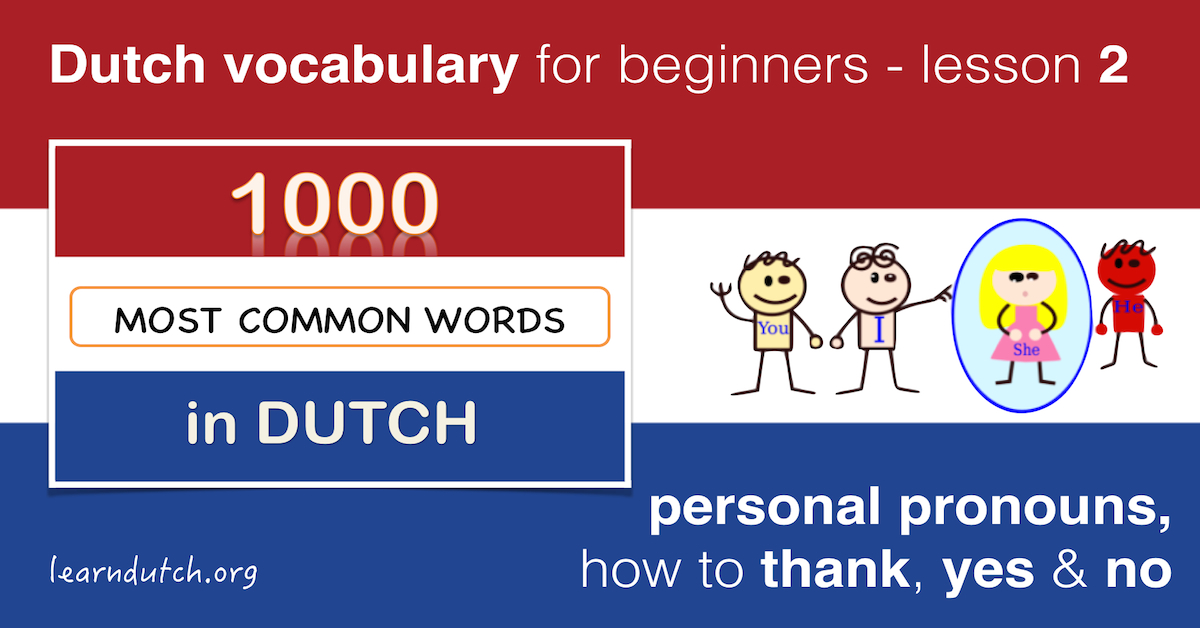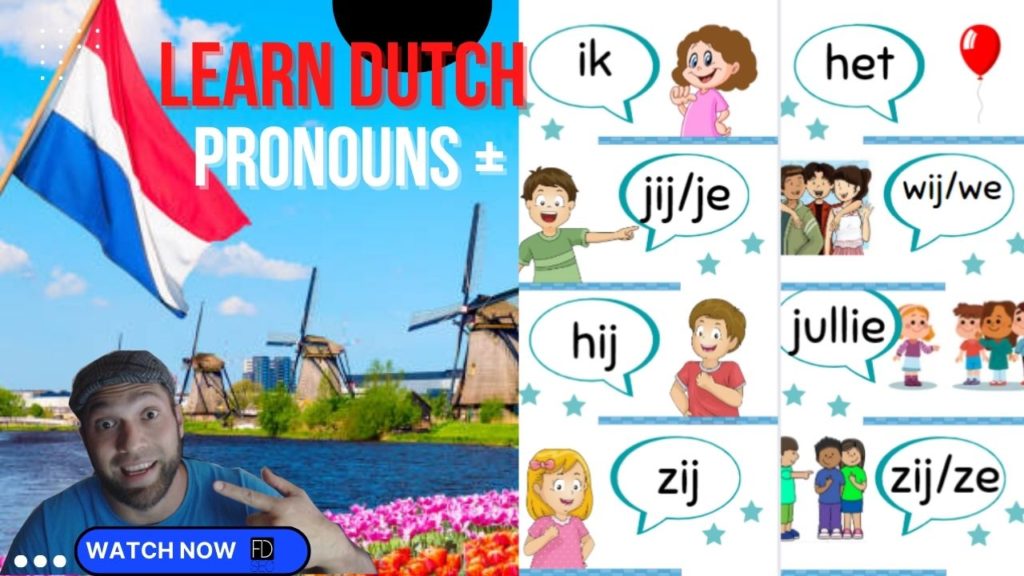
When to use DEZE, DIE, DIT en DAT in Dutch ? Demonstrative pronouns in Dutch explained ! YouTube
Personal pronouns are words such as I, me, your and it, words which are used to refer to a specific person or actor without having to mention them explicitly. Pronominal forms are a key element of all languages and must be learned early in one's linguistic journey to communicate effectively.

Dutch Round 1 personal pronouns YouTube
By Bieneke Berendsen. A reflexive pronoun is used when the subject and object of a sentence are one and the same, e.g. 'I wash myself". The subject is 'I' and the object 'myself' are the same person. The action that I carry out reflects back on to me, I undergo the washing myself. Hence, the word 'reflexive' pronoun.

Basic Dutch Grammar & conversation Learn Pronouns (Voornaamwoord) & Present tense
Nouns: De kat ("The cat ") Verbs: Wij lopen. ("We walk .") Adjectives (used to describe a noun): De kleine kat ("The little cat") Adverbs (used to describe a verb, an adjective, or another adverb): Ik ga morgen naar school. ("I will go to school tomorrow .") Pronouns (singular or plural):

Language Learning 60 seconds Chinese, HSK, language, learn, IELTS, Vocabulary, NTII
All Dutch personal pronouns (in free online video YouTube): I, you, he, she, we, you, they.- With example sentences. With alternative pronunciation: how do y.

Dutch personal pronouns that mean YOUR Learn dutch, Personal pronouns, Dutch words
Direct and indirect object pronouns are the same in Dutch, except for "them." Hen is used if it is a direct object, and hun is used if it is an indirect object. Generally, indirect objects are preceded by "to" or "from" in English, and direct objects are not preceded by any prepositions.

Learn Dutch Pronouns 🇳🇱 + free printable Dutch word list pdf 😀 YouTube
Learn Dutch online. Lesson 2 - Dutch personal pronouns, how to thank, yes/no.

Dutch for beginners (A1) the personal pronouns YouTube
Dutch pronouns include personal pronouns (refer to the persons speaking, the persons spoken to, or the persons or things spoken about), indefinite pronouns, relative pronouns (connect parts of sentences) and reciprocal or reflexive pronouns (in which the object of a verb is being acted on by verb's subject). Grammar Tips:

Dutch PRONOUNS 3 // The 4 functies of JE! shorts YouTube
v t e This article outlines the grammar of the Dutch language, which shares strong similarities with German grammar and also, to a lesser degree, with English grammar . Preliminary considerations Vowel length is indicated in Dutch spelling using a combination of double vowels and double consonants.

Dutch Personal Pronouns Basic Dutch vocabulary Lesson 2, new version! YouTube
to refer to a future event (in combination with an adverb of time) to refer to a hypothetical 'if - then' situation The Dutch word order Those of you who have already struggled with the Dutch word order probably know that the basic order of a Dutch main clause is as follows: subject | finite verb | time | manner | place | other verbs For example:

Learn Dutch Grammar _ Possessive Pronouns YouTube
Dutch for beginners (A1): the personal pronounsLet's learn the personal pronouns in Dutch. We'll review them all and you'll have the opportunity to pronounce.

Pronouns in Dutch language Voornaamwoorden in de Nederlandse taal Lesson 5 YouTube
Dutch pronouns consist of personal subject and object pronouns. They refer to people, animals or substances, without mentioning them in particular. The pronouns in Dutch are used very similarly to those in English, with an exception for the use of the T-V distinction, which means that there is use of formal and informal pronouns.

Dutch Vocabulary Personal Pronouns Learn dutch, Personal pronouns, Dutch language
Possessive names and nouns Colloquial possessives Reflexive pronouns Reflexive pronouns Reciprocal pronouns Reciprocal pronouns Interrogative pronouns Interrogative pronouns Demonstratives Demonstrative pronouns Dependent demonstratives Independent demonstratives Dit is, dit zijn Demonstratives turning into hier/daar Summary Dutch pronouns

Lesson 7 Demonstrative Pronouns and Negation in Dutch Teaching Resources
Possessive names and nouns Colloquial possessives Reflexive pronouns Reflexive pronouns Reciprocal pronouns Reciprocal pronouns Interrogative pronouns Interrogative pronouns Demonstratives Demonstrative pronouns Dependent demonstratives Independent demonstratives Dit is, dit zijn Demonstratives turning into hier/daar Summary Subject pronouns

Dutch vocabulary lesson 2 • Personal pronouns
There are some pronouns that you will be introduced to and start using from your very first Dutch lesson, and when you learn online with Babbel, you'll quickly decipher which are the most essential for use in everyday speech. You'll be introduced to common Dutch personal pronouns such as 'ik' (I), 'we' (we) and 'je' (you), including important.

Dutch grammar applied the personal pronoun as an object (object pronouns in Dutch) YouTube
Pronominal adverb 'er' Possessive pronouns Possessive pronouns Possessive pronouns examples Independent possessives Independent possessives examples Alternative possessive Possessive names and nouns Colloquial possessives Reflexive pronouns Reflexive pronouns Reciprocal pronouns Reciprocal pronouns Interrogative pronouns Interrogative pronouns

Dutch Pronouns A Guide to Subject Pronouns in Dutch Learn Dutch Online with Fluent Dutch
In Dutch, subject pronouns are used to indicate who or what is performing the action of a sentence. Unlike English, Dutch subject pronouns have different forms depending on whether the noun is singular or plural, and whether it is a masculine, feminine, or neuter noun. Let's take a closer look at the different forms of Dutch subject pronouns: